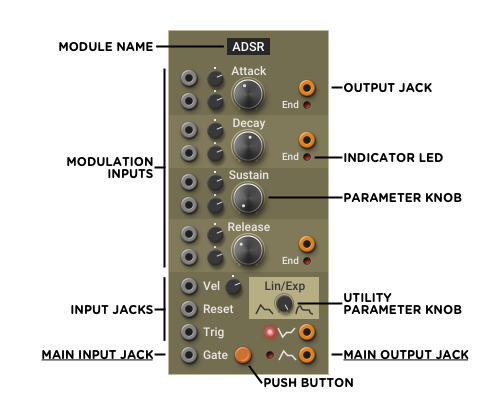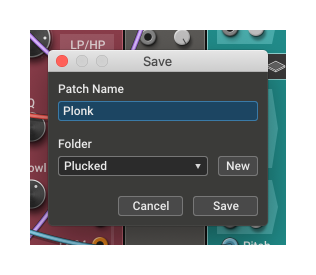Patching
Modular synthesis consists in producing sounds by connecting modules together with cables. These modules can generate or process audio and control signals.
The cables used to connect modules are called patch cables, the act of connecting modules is called patching, and the resulting creation is called a patch.
Building patches is done with five simple operations:
- adding modules,
- moving modules,
- removing modules,
- connecting modules,
- disconnecting modules,
These are explained in depth in the Building a Patch section. But before going any further, let’s take a look at what you may find in a typical module.
Anatomy of a Module ⚓︎
The following image shows the characteristics and layout patterns that are found in most modules.

- Module Name Tells you what type of module you are working with. Right-clicking (or command-clicking on Mac) on the name will open a pop-up menu with two commands: Show Online Help will open the manual page for the module, and Remove Module will remove the module from the rack.
- Output Jacks Orange jacks, located on the right side of the module, are for output. The output jacks at the bottom-right of the module are usually the main output jacks, where you will retrieve the signal produced or modified by the module. Some modules, such as the ADSR shown above, have some extra utility outputs.
- Input Jacks Grey jacks, usually found on the left side of the module, are for input. Many modules need an input signal to work; for those modules, the main input jack will be found at the bottom-left. Some inputs are located near a big knob and have their own attenuverter1: they are called modulation inputs. These are explained in depth in the Multiphonics Concepts—Modulations section.
- Parameter Knobs The labeled knobs are the knobs that will change how a module behaves. To turn a knob, click on it, hold the mouse button down and drag the mouse up or down. Many knobs have a default value, which is set by double-clicking on the knob. For fine-tuning, hold the Shift key down while turning the knob. Most knobs have modulation inputs located on their left or below. However, some utility knobs such as the Lin/Exp knob pictured above may not have them.
- Push Buttons These are used in some modules to trigger inputs by hand (as in the ADSR shown above), or to change between different mode of operation (such as the ×100 switch in the Pulse module).
- Indicator LEDs LEDs are found on many modules to show different aspects of the current module state.
Building a Patch ⚓︎
Adding Modules ⚓︎
Modules are found in the module browser. If the module browser is not currently visible, clicking in an empty part of the rack will show it.
A module is added by drag-and-dropping it from the browser, or by clicking on the + button next to the module image at the bottom of the panel.
When using drag-and-drop, the location where the module will be inserted is shown with an orange bar. Otherwise, the module will be inserted in the last row where you clicked in an empty spot.
Moving Modules ⚓︎
When your patch contains too many modules and connections, you may want to reorganize the modules in a different order to make the patch clearer. You can move a module by clicking on its name, holding the mouse button down and dragging it to the desired location.
The location where the module will be moved is shown with an orange bar. If no orange bar appears, there may not be enough space in the row. In that case, try dragging the module to a different row.
Removing Modules ⚓︎
A module is removed by right-clicking (or command-clicking on Mac) on its name and choosing Remove from the pop-up menu.
Connecting Modules ⚓︎
Modules are connected by performing a drag-and-drop operation from one jack to another: click on the source jack, hold the mouse button down and drag the patch cable to the target jack.
Connections are always between an output jack (orange) and an input jack (grey). An output jack may have many cables connected into it, so the same source can easily be sent to different parts of the patch. However, an input jack can only have one connection.
To connect many different sources into the same input jack, add a mixer, like the Mix 8 module, connect all sources into the mixer input, and connect the mixer output to the targetted input jack. The mixer will also let you adjust the relative volume of each source.
The following video shows how to create a very simple synth by connecting the sawtooth output of a Classic VCO to the input of a VCA, the output of the VCA to the audio output, the Keyboard Gate to the CV input of the VCA to let the sound through when a note is played, and the Keyboard Pitch to the VCO Pitch to play the right note.
If patch cables obscure important controls in some modules, you can make them transparent or invisble by changing the Cable Opacity setting from the View menu in the toolbar.
Multiphonics does not impose any restrictions on how the modules are connected to each other. A patch can have any number of feedback loops, and a module can even be connected to itself.
Disconnecting Modules ⚓︎
There are two ways to disconnect patch cables:
- For input jacks only Click and hold the left mouse button and move the cable to an empty spot of a module, or to another input jack to reconnect it there.
- For any jack Right-click (or command-click on Mac) on the jack and choose Delete Cable from the pop-up menu. This will remove all cables connected to that jack.
These two techniques are demonstrated in this video:
Saving Patches ⚓︎
When you like what you hear, you can save your patch to the User collection of the patch browser.

Enter the patch name in the text field at the top, choose a folder from the drop-down list or create a new one with the New button, and click on Save to save the patch to your User collection.
A patch file stores everything you see in the rack (modules, connections, knob settings), as well as the current settings from the effects panel
When using Multiphonics as a plug-in in a DAW, saving the project in the DAW will automatically store the rack, effect panel and setting panel contents in the project.
If you load a patch from the User collection, modify it and save it with the same name, it will replace the original file without asking.
If you load a patch from the Factory collection and save it with the same name and in the same folder, it will not overwrite it in the Factory collection since it is read-only. Instead, a new folder with the same name will be created in the User collection, and the patch will be stored in that folder. When showing all patches in the browser, the saved patch will appear twice: once with [Factory] and once with [User] appended to its name.
Video Tutorials ⚓︎
The quickest way to get a hang of patching is to fire up Multiphonics and build some patches. To help you get started, we created some video tutorials you can follow:
We will be adding more tutorials on different subjects in the future.
-
Attenuverter is a contraction of the words attenuator and inverter. An attenuverter is a special kind of volume knob. When it is centered (0%), the signal is blocked. When it is turned clockwise from the center position, it behaves like a normal volume knob up to 100% where it lets the whole signal through. When turned counterclockwise from the center position, it will also act like a volume knob, but it will invert the signal polarity as well. For example, at –100% (fully counterclockwise), an input of 5V would become –5V. ↩
